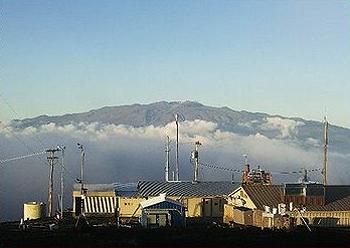
MAUNA LOA OBSERVATORY, Hawaii, May 11, 2013 (ENS) – For the first time in human history, concentrations of the greenhouse gas carbon dioxide, CO2, have risen above 400 parts per million, ppm. Many climate scientists warn that 350 ppm is the safe upper limit for CO2 in the atmosphere.
On May 9, the daily mean concentration of carbon dioxide in the atmosphere of Mauna Loa, one of the volcanoes on the Big Island of Hawaii, surpassed 400 parts per million for the first time since measurements began in 1958, when CO2 concentrations averaged 318 ppm.

Independent measurements made by both the National Oceanic and Atmospheric Administration, NOAA, and the Scripps Institution of Oceanography have been approaching this level during the past week. Having two programs independently measure the greenhouse gas provides confidence that the measurements are correct.
It marks an important milestone because Mauna Loa, as the oldest continuous carbon dioxide, CO2, measurement station in the world, is the primary global benchmark site for monitoring the increase of this heat-trapping gas.
“Carbon dioxide pumped into the atmosphere by fossil fuel burning and other human activities is the most significant greenhouse gas contributing to climate change,” said NOAA, announcing the 400 ppm concentration level.
CO2 concentration has increased every year since scientists started making measurements on the slopes of the Mauna Loa volcano. The rate of increase has accelerated since the measurements started, from about 0.7 ppm per year in the late 1950s to 2.1 ppm per year during the last 10 years.
“That increase is not a surprise to scientists,” said NOAA senior scientist Pieter Tans, with the Global Monitoring Division of NOAA’s Earth System Research Laboratory in Boulder, Colorado. “The evidence is conclusive that the strong growth of global CO2 emissions from the burning of coal, oil, and natural gas is driving the acceleration.”
During the last 800,000 years, concentrations of CO2 in the atmosphere fluctuated between about 180 ppm during ice ages and 280 ppm during interglacial warm periods.
There were around 280 ppm of CO2 in the 19th century atmosphere before the Industrial Revolution, when humans first began releasing large amounts of CO2 to the atmosphere by the burning of fossil fuels.
Today’s rate of increase is more than 100 times faster than the increase that occurred when the last ice age ended.
It was researcher Charles David Keeling of the Scripps Institution of Oceanography, University of California, San Diego, who began measuring carbon dioxide at Mauna Loa in 1958, initiating now what is known as the “Keeling Curve.” His son, Ralph Keeling, also a geochemist at Scripps, has continued the Scripps measurement record since his father’s death in 2005.
“There’s no stopping CO2 from reaching 400 ppm,” said Ralph Keeling. “That’s now a done deal. But what happens from here on still matters to climate, and it’s still under our control. It mainly comes down to how much we continue to rely on fossil fuels for energy.”
“At this pace we’ll hit 450 ppm within a few decades,” said the younger Keeling.
“This needs to be a wake-up call,” said Melanie Fitzpatrick, climate scientist at the nonprofit Union of Concerned Scientists, based in Cambridge, Massachusetts. “Reaching 400 parts per million represents a dire experiment with the climate system. As long as humans have walked the Earth, we’ve never seen carbon dioxide levels this high.”
“If we don’t reduce carbon soon, we may no longer talk about searing summer temperatures, 100-year storms and intense droughts as something unusual because they may be the norm. When I started giving talks on climate change in the early 1990s,” said Fitzpatrick, “I was bemoaning the fact that carbon dioxide levels had reached just over 350 parts per million. Now I only wish for that level.”
In London, Lord Nicholas Stern, head of the Grantham Research Institute on Climate Change, warns that massive movements of climate refugees, driven from their homes by rising temperatures, will come into conflict with other groups living in cooler, wetter climates.
“When temperatures rise to that level, we will have disrupted weather patterns and spreading deserts,” Lord Stern told “The Guardian” newspaper. “Hundreds of millions of people will be forced to leave their homelands because their crops and animals will have died. The trouble will come when they try to migrate into new lands, however. That will bring them into armed conflict with people already living there. Nor will it be an occasional occurrence. It could become a permanent feature of life on Earth.”
Rising temperatures are shrinking polar ice caps, reducing the amount of solar heat they reflect back out into space. Scientists warn that thawing of the permafrost in Alaska, Canada and Russia could emit even more greenhouse gases, including the potent greenhouse gas methane, further intensifying global warming.
Similar increases of CO2 are seen all over the world by many international scientists. NOAA, which runs a global, cooperative air sampling network, reported last year that all Arctic sites in its network reached 400 ppm for the first time.
These high values were a prelude to what is now being observed at Mauna Loa, a site in the subtropics, this year. Sites in the Southern Hemisphere will follow during the next few years.
The increase in the Northern Hemisphere is always a little ahead of the Southern Hemisphere because most of the emissions driving the CO2 increase take place in the north, NOAA explained.
Once emitted, CO2 added to the atmosphere and oceans remains for thousands of years. Climate changes forced by CO2 depend primarily on cumulative emissions, making it progressively more and more difficult to avoid further substantial climate change.
Scientists estimate that the last time CO2 concentrations in the atmosphere were as high as 400 ppm was probably the Pliocene epoch, between 3.2 million and five million years ago, when Earth’s climate was much warmer than it is today.
Copyright Environment News Service (ENS) 2013. All rights reserved.
